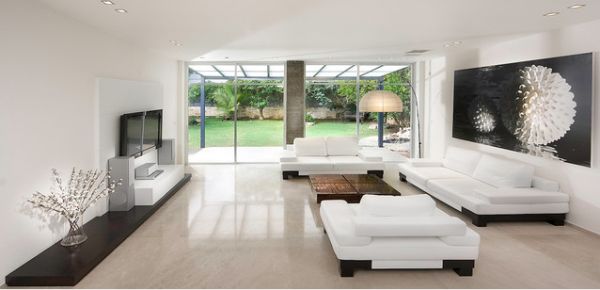Designer tips for spaces with low ceilings
Of all the surfaces that create a space – ceilings, walls, and floors – the one plane that often seems to have the biggest impact is the ceiling. If there are acoustical issues in a room, adding panels to the ceiling with help more than adding panels on the wall or carpet on the floor. The ceiling is often the surface that provides light, as fixture are mounted or suspended from it. And the ceiling height itself affects how people think and feel. Tall ceilings help to make the room seem more spacious, not only brightening the space, but also people’s outlooks. Low ceilings can feel oppressive and have a negative impact on mood.

Not all of us are blessed with tall ceilings though, and in many cases, there is no opportunity to physically raise the ceiling. However, there is hope. There are a few tricks that designers often use to make a low ceiling seem taller.
Opt for Floor to Ceiling Curtains.

Most people size curtains to fit the window width and height, using them primarily to block light when needed and add privacy. However, rethinking the use of curtains can help a room feel more spacious. Rather than hanging curtains just above the window, move the curtain rod all the way to where the wall meets the ceiling. This allows the panels of curtains to hang to the floor, emphasizing the vertical nature of the panels and making the ceiling seem higher. Also, when hanging curtains, allow for the curtains to completely bypass the window. This will make the window seem larger when the curtains are open, and larger windows always help to make the room seem more spacious.
Emphasize Verticality.

Much like the curtain tip, another way to make a low ceiling seem taller is to create vertical lines on the wall. This helps to move the eye up and down instead of horizontally. This can be done several ways, such as using artwork that is taller than it is wide, using tall, thin windows, or creating a pattern on the wall. There are many wallpaper patterns featuring vertical stripes, or this can be done using paint. If the stripe pattern is not your preference, try creating the pattern by alternating matte paint with glossy paint of the same color, which creates a subtle, monotone pattern instead of one with bold, contrasting colors.
Choose Light Paint Colors.

One of the recent popular trends in decorating is to paint the ceiling plane a contrasting color instead of the typical ceiling white. This can be devastating for spaces with low ceilings, making the ceiling seem even lower and more oppressive. While the space shown in the photo above is quite nice and cozy, the ceiling would be far less noticeable if it were painted a lighter shade. Also, using lighter colors on walls, particularly in small spaces, such as bathrooms, can help the room seem more spacious.
Avoid Protruding Objects.

If the ceiling in a space is lower, avoid hanging ceiling fans and pendant lights from it. Instead, opt for recessed fixtures or can lights. Fixtures that hang from the ceiling break up the visual field and cause one to look at the object, and therefore, the ceiling itself. Using fixtures that do not protrude into the visual field helps to open the space up and allows the ceiling to blend.
Along with protruding objects on the ceiling, protruding objects at the top of the wall, such as crown molding, should also be avoided. Crown molding will emphasize the horizontality of the edge of the ceiling, which will make it feel lower. If you prefer crown molding, choose one with a low profile for spaces with low ceilings.
Make Your Accessories Assist.



What goes into a space with a low ceiling can have a great impact too. Opt for lower furniture, which again helps to open the field of vision. Taller furniture breaks up the space, and can make it feel smaller, while lower furniture increases the space between it and the ceiling. Also, hang artwork higher, which helps to draw the eye upward. And you can even look for artwork that includes vertical lines and features.
